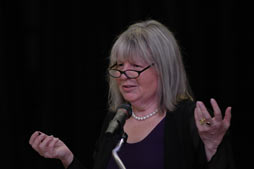By Chris Webb/nw news editor
Broadcast television is going digital.
As a result of a Congressional mandate, all over-the-air television stations will broadcast a digital signal beginning Feb. 17, 2009.
This change is not quite as sudden as it seems.
Plans have been in motion since 1996. That year, Congress issued an extra broadcast channel to every TV station affected by the transition. Networks could then begin transferring to digital without interfering with the analog signal already in broadcast.
But Rick Anderson, chief engineer at KDAF/CW33 in Dallas-Fort Worth, said the transition has not been easy for broadcast companies.
“It’s true that we were given an extra station to work with, but we still had to build a whole new structure, essentially building another TV station within a TV station,” he said. “On average, stations could spend anywhere between $2 million to $5 million setting up the new digital network.”
When asked if the government had compensated them, or planned to in any way, Anderson replied with a chuckle and a “no.”
Hype and rumors surround this switch, but it will be easier than some may assume.
According to the Federal Communications Commission, the switch will not affect cable or satellite channels, just the signal that delivers local channels.
Rumors have also led some to believe that they must get a new TV or get left in the dark, literally. This simply is not the case; some older TVs will need to be upgraded, but the process will be relatively painless.
According to the FCC, the only modification analog TVs will have to go through is plugging in a digital-to-analog converter box. These boxes are estimated to retail at $50 to $70 each.
The switch does not mean consumers need a high-definition television set; if they own one now, they can view all of their local programming in HD.
Many TVs are already equipped with a digital receiver. But any TV being sold in retail that is not, by law, has to display a consumer alert that clearly says so.
The government will offer a coupon program to help consumers with the cost of upgrading their sets.
Every household will be eligible for as many as two $40 coupons toward the purchase of a converter box. Only one coupon can be redeemed per box.
Even with these converter boxes, some will still be in the dark. A recent study by Centris, a market research firm in Los Angeles, reveals that as many as 5.9 million TV sets will not be able to receive as many stations as before the transition.
Congress’ motivation behind this mandate may come as no surprise—money.
Shutting the analog signals down will open up a large portion of the broadcast spectrum, which is the limited range of airwave frequencies currently controlled by the FCC.
Two-thirds of the airwaves will be divided and auctioned to the highest bidder. The other third will be distributed to public service agencies like police and fire departments.
It’s still unclear what the corporations that buy these frequencies will do with them, but in the electronic world, these frequencies are like limited prime real estate.
Starting bids are currently set around $4 billion but are expected to climb dramatically.
The change may be unwelcome for some, but with new technology comes new features and benefits.
Digital signals are free from problems such as static fuzz, lines or any of the other interferences that plagued analog TV.
DTV will also make way for new features such as “multicasting,” which the FCC describes as several simultaneous programs on one broadcast channel. This feature will allow broadcasters to run multiple shows during the same time slot.
Many networks are already broadcasting a digital signal, and most that are not have already made preparations.
Either way, analog will be going dark in ’09. All that’s left to see is how the purchasing corporations will use the frequencies.

























